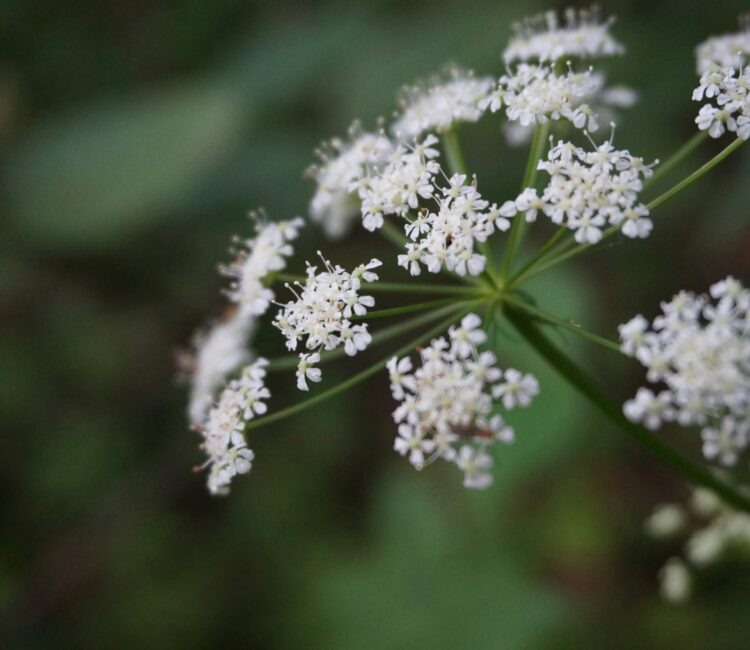The Apiaceae family, also known as the Carrot or Parsley family, includes over 3,700 species renowned for their distinctive umbrella-shaped flower clusters and aromatic qualities. From familiar kitchen herbs like parsley, coriander, and fennel to powerful medicinal plants such as angelica, this diverse family has deep roots in history, herbal medicine, and culinary traditions. In this guide, we’ll uncover the fascinating botanical traits, historical uses, health benefits, and important safety tips of the Apiaceae family to help you appreciate and work with these versatile plants safely and effectively.
Botanical Profile:
- Apiaceae Family (1)
- ~434 genera (1)
- ~3,700 species (1)
- Common traits of the family include: hollow stems, taproots and flat-topped flower clusters known as umbels. (1)
- Widely distributed around the world, but prefers the temperate climate of the Northern hemisphere. (2)
- Origin: Australasia, Southern Hemisphere. (3)
Historical Overview
Through scientific research and genetic investigation, we know that the Apiaceae family has its origins in what we now know to be the Indo-Australian archipelago. Archaeologists have traced the first use and cultivation of this family back to around 3000 BC. Who can blame the ancients for recognising the strong aromatic flavours and health benefits of many plants from this family?
Becoming hardy plants the family spread through the continents and now prefers the temperate climate of the Northern Hemisphere. That’s where we encounter a lot more information about its history with humankind. (12)
Ancient Egypt & Greece
The ancient Egyptians offer us an early glimpse into how herbs like coriander (Coriandrum sativum), dill (Anethum graveolens), and fennel (Foeniculum vulgare) were valued—often found in the burial crypts of their deceased, alongside many records of their uses. Coriander was praised for its antiseptic properties and aiding digestion. Fennel earned a well-deserved reputation for its versatility, soothing everything from digestive troubles to minor eye irritations.
Apiaceae Family took the Mediterranean by storm. Greeks didn’t just use herbs like parsley (Petroselinum crispum) and coriander for their culinary and medicinal properties. Oh no, they took it a step further incorporating them into their spiritual beliefs symbolism. Coriander was seen as a symbol of the soul’s immortality. Because of this, it was often laid to rest in tombs alongside the departed. Parsley was believed to have sprouted from the blood of a baby Archemorus, the forerunner of death and was widely used in burial rituals. (4)
Roman Empire
During the Roman Empire’s reign, many plant families travelled far and wide across Europe and Africa. This spread often followed Roman troops as they journeyed into new lands. Many plants were a staple in their first aid boxes and that includes members of the Apiaceae family.
In Roman literature, celery (Apium graveolens) is repeatedly noted for its ability to reduce inflammation. Coriander, dill, and fennel were treasured not only for their aromatic flavours in the kitchen but also for their gentle support of digestion—helping ease bloating and even regulating appetite. (4)
In the Roman Empire, we also see the emergence of one of the greatest-known scholars in history, Pliny the Elder. His studies are well known and his encyclopaedias are still in use today. He wrote quite extensively about members of the Carrot Family. Let’s see what he has to say about wild parsnips:
“The seed of this plant, pounded and taken in wine, reduces swelling of the abdomen, and alleviates hysterical suffocations and pains, to such a degree as to restore the uterus to its natural condition.“
Translation to common: helps with menstruation symptoms relief. (6)
The Middle Ages
The Medieval times gave the Apiaceae family’s regenerative properties a whole new fame. Herbalists, monks, and nuns nurtured many healing herbs in their monastery gardens, carefully cultivating them to create trusted remedies. Angelica (Angelica archangelica) was highly cultivated as it was believed to be protective against the plague. It was used in tinctures, tonics and as incense to purify the air.
Other members of the family were carefully studied over time, revealing even more of their healing gifts. Parsley tea was traditionally used to soothe respiratory troubles, helping to loosen mucus and ease coughing. Others kept their strong position in kitchens and home apothecaries. (4)
Renaissance
What was once passed down as home remedies and local apothecary wisdom gained official recognition during the Renaissance, taking its rightful place in the world of medicine under the name ‘Herbalism’. Many herbalists we know and recognise as Fathers of modern herbalism had their start during that time. Botany research was very popular and many plants were gaining even more recognition for their healing properties.
Nicholas Culpeper is one of the most recognisable names in Herbalism to date, and not without a reason. He wrote extensively about many plants, possibly while using a lot of them on himself and is well known for the strong opinions, he was not afraid to put into his scientific texts:
“It is an herb of the Sun in Leo. It expelleth all poison, and drives away all pestilential and contagious airs.”
A short quote about Angelica, I think, shows his style well. We shouldn’t discredit him for having strong views—many of us hold firm opinions, we just don’t always share them openly. I think I honestly respect him more for voicing his views. Much of his work remains solid and has been confirmed by modern research. (5)
Modern Age
Currently, thanks to global trade, many plant species are spread worldwide. What once grew wild in Asia, like carrots, has now become a staple in kitchens worldwide. Many herbs have a permanent place in our home gardens as we appreciate their fragrance and flavours. Coriander is highly praised in Mexican cuisine, just as parsley is in India and the Mediterranean.
As the Western world rapidly advanced, many folk remedies were quietly set aside in favour of modern pills. However, the progression of Western medicine would not have happened without them. Many of us continue to rely on these remedies today, whether as supplements or extracts and still celebrate their healing benefits. A number have found their way into alternative forms, like aromatherapy, for a very long time. We are starting to slowly revert back to those folk remedies, as modern herbalism is showing us none of these were forgotten. Ha! I’ll go as far as to say, they can do a lot more for us than we realise. This movement is revitalising the attention plants solemnly deserve for the benefits they bring us. What plant remedies and supplements do you use? I’d love to hear your thoughts—drop a comment below! (7)
Overview of the Carrot Family
There are some characteristics, which the majority of members of the Carrot family share. I will be doing a deep dive into foraging guides in the future, but I want to give you an idea of the common traits within the family. Remember, the Apiaceae family contains deadly members, so don’t pick unless you’re 100% sure of identification.
Quick Identification Guide
The most recognisable feature of this family is their small, umbrella-like flower clusters, known as compound umbels. If you look closely, the stems and flowers spread out from a single stalk, creating a delicate double umbrella — which is why it’s called ‘compound.’ Many members also have square, soft hollow stems; alternating leaves are often compound, fern-looking; most are aromatic and are extracted into essential oils. (8)
Growing Conditions
In the wild, the Apiaceae family tends to thrive in disturbed soils, where their resilience truly shines. Roots don’t like to be compacted as it stunts their growth. What they really appreciate is rich, nutritious, well-draining soils. You’ll often find many members of this family growing along pathways, in fields, meadows, and even in private gardens—places where human and animal activity creates the perfect conditions for them to thrive. (9)
Most plants in the Carrot family thrive in full sun for much of the day, though many tolerate partial shade—and some, like coriander, actually prefer a touch of it. They grow and are foraged throughout spring and summer, whenever those conditions come together. That’s why so many of those plants make a great cultivation species, like carrots, as they are relatively adaptable to most environments we live in. (9)
Environmental Impact
Mama Gaia cherishes balance and works hard to maintain it, however, with humans and plants spreading far and wide, some of that harmony has been unsettled. Many plants carried into new environments have brought gifts, whilst some have also disrupted the delicate balance of their new homes. Let’s see how the Apiaceae family does with this situation:
Positive Impact
- Pollinators love them – in spring the Carrot family is one of the primary sources of food for many pollinator species, including bees, butterflies and many others! This, in turn, boosts local biodiversity by attracting pollinators to nearby crops. Many are also crucial in the life cycle of insects, especially the wild varieties.
- Companion Plants – They serve an essential role as companion plants to many crop fields supporting their growth. In attracting pollinators, they also attract many predatory insects. By doing this, they play a vital role in pest control, drawing predatory insects away from our crops. This can reduce the need to use harsh chemical pesticides.
- Soil improvement – happens thanks to species like carrots, parsnips, and fennel, whose deep roots help oxygenate the earth as they grow. This prevents the area from over-compacting, allowing more seeds to find their homes. As they decompose, they also provide vital nutrition to the ground. (9)
Negative Impact
- Invasiveness – unfortunately, some species of the family are highly invasive, outcompeting and suffocating native species. Some examples include:
- Bur Chervil (Anthriscus caucalis)
- Alexanders (Smyrnium olusatrum)
- Cow Parsnip (Heracleum maximum)
- Human Safety – many members of this family are highly poisonous and can even cause death in humans. Do not forage for them unless you’re 100% sure of the identification. Some examples include:
- Poisonous Hemlock (Conium maculatum)
- Fool’s Parsley (Aethusa cynapium)
- Spotted Cowbane (Cicuta virosa)
- Monoculture Farming – is an unfortunate reality of cultivation currently. Many farmers keep a single type of crop on one field for several seasons. I can understand why it’s done, but it’s not a practice that truly benefits the soil. Crops like carrots are heavy feeders, quickly using up nitrogen in the soil. This can lead to soil degradation, meaning more harsh fertilisers are needed to restore the balance. One way to remedy this issue would be to circulate the fields between different crops, some crops are more restorative than others for the soil. (9)
Common Herbs from This Family & Their Uses
Now, let’s explore a few of the most well-known medicinal plants from this family and discover how they continue to support our health today.
Fennel (Foeniculum vulgare)
Fennel has been with us for a very, very long time. We all know it, most of us love its fragrance and flavours. What benefits it brings along with it:
- Digestive aid in the form of bloating and indigestion relief.
- Friend of the Ladies, containing phytoestrogens can help reduce menstrual cramps and possibly alleviate some menopausal symptoms. It has also been found to increase lactation. (3)
The most common preparations for fennel include:
- Tea from seeds
- Tinctures made of seeds and plant matter, like leaves and stalks.
- Essential oil extract, diluted down for aromatherapy and topical use. (10)
Coriander (Coriandrum sativum)
Just like its colleague above coriander has accompanied humankind for many years. It’s widely used in culinary preparations and appreciated for its strong and refreshing flavour. But there is much more to coriander than good food, let us take a look:
- Digestive aid reduces bloating and stimulates appetite.
- Detox, especially its ability to bind heavy metals and help remove them from the body.
- Anti-inflammatory, on top of the above it’s highly rich in antioxidants. (12)
The most common preparations of coriander include:
- Eaten fresh, in foods, juices, smoothies.
- Tea from seeds and leaves.
- Essential oil extract, diluted down for aromatherapy and topical use. (10)
Angelica (Angelica archangelica)
We’ve touched on Angelica earlier in its spiritual role, where it’s burned as incense during rituals. Let us not forget how much more she can give us:
- Respiratory support is most commonly used for colds and coughs.
- Digestive aid serves as a digestion stimulant and helps to reduce bloating.
- Another friend of the Ladies, it can help regulate the cycle and relieve menstrual pains. (3)
The most common forms include:
- Tea or a decoction from the root. (We’ll get into the differences between tea and decoction in another post)
- Tincture, also from the root.
- Powder from the root is used to press pills or capsules. (10)
Conclusion:
Apiaceae family is one of the better-known families to us. It has deep roots in humankind in many aspects. The members of this family are true friends to our digestion—and they deserve more respect and study to uncover what other secrets they might be holding. Perhaps you know of a few facts or uses we haven’t covered here? Let me know in the comments below! I’d love to see how you incorporate those amazing plants into your life <3
2. Apiaceae: Parsley or Carrot Family. Identify herbs, plants, and flowers. (n.d.). Retrieved 6 June 2025, from https://www.wildflowers-and-weeds.com/Plant_Families/Apiaceae.htm
3. Wang, X.-J., Luo, Q., Li, T., Meng, P.-H., Pu, Y.-T., Liu, J.-X., Zhang, J., Liu, H., Tan, G.-F., & Xiong, A.-S. (2022). Origin, evolution, breeding, and omics of Apiaceae: A family of vegetables and medicinal plants. Horticulture Research, 9, uhac076. https://doi.org/10.1093/hr/uhac076
4. Elder, P. (n.d.). The Natural History (Vol. 6).
5. Grieve, M. (1996). A modern herbal: The medicinal, culinary, cosmetic, and economic properties, cultivation, and folklore of herbs, grasses, fungi, shrubs, and trees with all their modern scientific uses.
6. Hoffmann, D. (2003). Medical Herbalism: The Science and Practice of Herbal Medicine. Inner Traditions International, Limited.(2021, January 12).
7. Garden Plant Families – Apiaceae – the Parsley Family. Miles Away Farm Blog. https://milesawayfarmww.com/2021/01/12/garden-plant-families-apiaceae-the-parsley-family/
8. List of plants in the family Apiaceae | Herbs, Spices, Vegetables | Britannica. (n.d.). Retrieved 6 June 2025, from https://www.britannica.com/topic/list-of-plants-in-the-family-Apiaceae-2038061
9. Morin, N. R. (with Flora of North America editorial committee). (2009). Flora of North America: North of Mexico paeoniaceae to ericaceae. Oxford University Press.
10. Benzie, I. F. F., & Wachtel-Galor, S. (Eds.). (2011). Herbal medicine: Biomolecular and clinical aspects (2nd ed). Taylor & Francis.
11. Thayer, S. (2023). Sam Thayer’s field guide to edible wild plants of eastern & central North America. Forager’s Harvest Press.
12. Culpeper, N. (with Pursell, J. J.). (2022). Culpeper’s complete herbal: A compendium of herbs and their uses, annotated for modern herbalists and witches (New edition). Microcosm Publishing.
STAY CONNECTED WITH NATURE
“In every leaf, a remedy. In every remedy, a story.” 🌿



LEAVE YOUR COMMENT
Your email address will not be published. Required fields are marked *